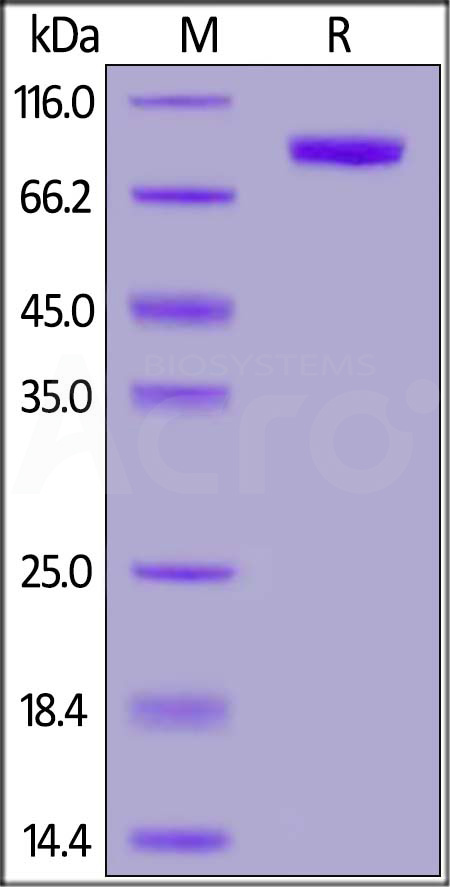分子别名(Synonym)
PIGR,Poly-Ig receptor
表达区间及表达系统(Source)
Human pIgR, His Tag (PIR-H5222) is expressed from human 293 cells (HEK293). It contains AA Lys 19 - Arg 638 (Accession # AAI10495.1).
Predicted N-terminus: Lys 19
Request for sequence
蛋白结构(Molecular Characterization)

This protein carries a polyhistidine tag at the C-terminus.
The protein has a calculated MW of 68.7 kDa. The protein migrates as 90-100 kDa under reducing (R) condition (SDS-PAGE) due to glycosylation.
内毒素(Endotoxin)
Less than 1.0 EU per μg by the LAL method.
纯度(Purity)
>95% as determined by SDS-PAGE.
制剂(Formulation)
Lyophilized from 0.22 μm filtered solution in PBS, pH7.4. Normally trehalose is added as protectant before lyophilization.
Contact us for customized product form or formulation.
重构方法(Reconstitution)
Please see Certificate of Analysis for specific instructions.
For best performance, we strongly recommend you to follow the reconstitution protocol provided in the CoA.
存储(Storage)
For long term storage, the product should be stored at lyophilized state at -20°C or lower.
Please avoid repeated freeze-thaw cycles.
This product is stable after storage at:
- -20°C to -70°C for 12 months in lyophilized state;
- -70°C for 3 months under sterile conditions after reconstitution.
电泳(SDS-PAGE)

Human pIgR, His Tag on SDS-PAGE under reducing (R) condition. The gel was stained with Coomassie Blue. The purity of the protein is greater than 95%.
背景(Background)
Polymeric immunoglobulin receptor (PIGR) is also known as Poly-Ig receptor, which can be cleaved into membrane secretory component (SC). PIGR is a type I transmembrane glycoprotein or a member of the immunoglobulin superfamily, and is synthesized by secretory epithelial cells and delivered to the basolateral plasma membrane where it can bind larger polymers of IgA (pIgA ) and pentameric IgM. The complex is then transported across the cell to be secreted at the apical surface. During this process a cleavage occurs that separates the extracellular (known as the secretory component) from the transmembrane segment.























































 膜杰作
膜杰作 Star Staining
Star Staining











